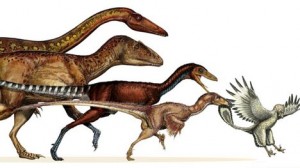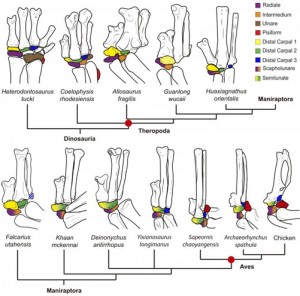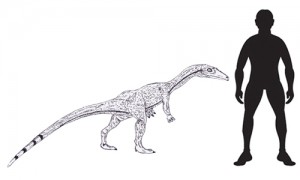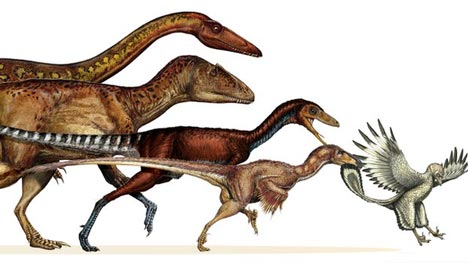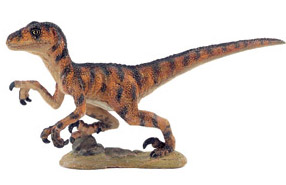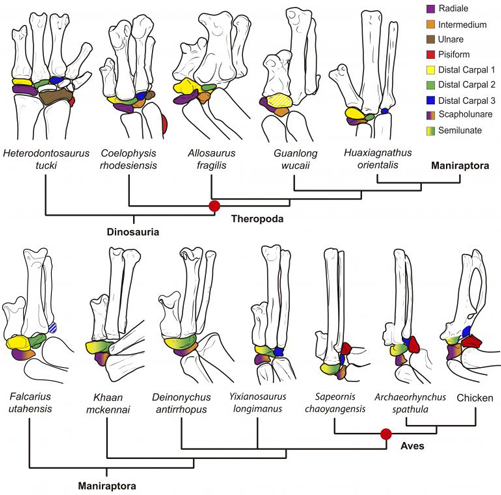Evolution of Dinosaur Arms into Bird Wings Mapped in New Study
Scientists Demonstrate how Dinosaur Arms Evolved into the Wings of Birds
A team of researchers based at the University of Chile (Santiago, Chile) have resolved a mystery surrounding one of the anatomical puzzles related to the theory that birds are descended from meat-eating dinosaurs. Whilst it is now widely accepted that modern birds are descended from a group of dinosaurs called the theropods, the wrist bones of many dinosaurs including members of the Theropoda are very different from the wrist bones of birds. Many types of early dinosaur had nine wrist bones, birds today, only have four. Can the theory of evolution explain these changes?
Robust, Strong Immobile Wrists of Dinosaurs Versus the Hyper-flexible Wrist of Aves
The dinosaurs which are most closely related to modern birds walked on their hind feet. Their forelimbs were not involved in locomotion. They became adapted for a number of functions, primarily related to food gathering. Most of the theropod dinosaurs were meat-eaters. The wrist evolved as a relatively strong and immobile joint to help subdue prey or to assist in attacking other animals.
The wrist joint in birds helps to manage the forces involved in the movements of the wing in flight. They also permit the wings to be folded back when the bird is not flying, so how the wrist bones of dinosaurs evolved into the specialised and highly modified wrist bones of birds has been the subject of much debate.
The Evolution of Dinosaurs to Birds
Picture credit: Davide Bonnadonna.
Two Distinct Research Techniques
The University of Chile team, published a paper in October 2014, that used two distinct research techniques to help solve the mystery of why dinosaur wrist bones are very different from the wrist bones of birds.
- Technique 1 – staining proteins in the developing embryos of extant birds and reptiles to see how the wrist bones are formed
- Technique 2 – studying the fossilised wrist bones from dinosaurs and extinct birds
Mapping Evolutionary Changes
The scientists were able to map evolutionary changes in the Dinosauria and primitive birds that showed how wrist bones evolved over time to resemble those bones found in birds. The embryo studies, using the newly developed technique of whole-mount immunostaining, showed that one of the wrist bones found in birds, the semilunate had actually formed from two fused dinosaur bones (distal carpal 1 and distal carpal 2).
Mapping the Evolution of Bones in the Wrist (Dinosaurs to Birds)
Picture credit: PLOS Biology
The above chart shows the phylogenetic relationship diagram that helps explain how dinosaur wrist bones evolved eventually into the four, square-shaped bones found in the wrist of a modern bird (chicken). The coloured bones relate to bones found in modern birds.
Dinosaur Arms
The Early Jurassic dinosaur called Heterodontosaurus, is believed not to be very closely related to modern birds. Heterodontosaurus was an ornithopod, not a theropod. It had a total of nine bones in its wrist.
There are some similarities between this dinosaur and the wrists of birds, but Heterodontosaurus may also have used its forelimbs for walking. Coelophysis from the Triassic was a theropod and therefore more closely related to birds. This dinosaur was very probably entirely bipedal. Note in the evolutionary diagram above, the presence of a small red bone located close to the ulna arm bone in both Heterodontosaurus and Coelophysis. This is the pisiform bone, a pea-shaped bone found in birds but not in later theropod dinosaurs such as Allosaurus, Guanlong, Deinonychus and Yixianosaurus.
An Illustration of Coelophysis (Scale Drawing)
Picture credit: Everything Dinosaur
The South American research team discovered that some bones in the wrist of dinosaurs were lost, some fused to form a single bone as seen in birds today and the pisiform, once lost in the Dinosauria, re-evolved as the wrist became adapted to accommodate the forces associated with powered flight.
A New Research Technique
The newly developed technique of whole-mount immunostaining permitted the research team to see how proteins grouped together in embryonic birds to form cartilage that later became bone. The semilunate bone (yellow and green in the diagram) starts of as two separate areas of cartilage in the embryo which then fuse to form a single bone. Palaeontologists have long believed that that semilunate bone is a fusing of two wrist bones from the ancestral dinosaurs (distal carpal 1 and distal carpal 2), this new research seems to support this theory.
The study also produced an interesting surprise, when they discovered a wrist bone called the pisiform (in red in the diagram), which was present in the ornithopod Heterodontosaurus and primitive theropods but later disappeared in more advanced theropods from the Jurassic and Cretaceous.
Commenting on this discovery, lead author of the research paper, Dr Alexander Vargas stated:
“We think the pisiform was lost when dinosaurs became bipedal. Quadrupedal animals used this bone because they walk with their forelimbs, but bipedal dinosaurs no longer walked with their forelimbs and lost the bone. However they regained it when they began using their forelimbs for locomotion in flight.”
Mapping Proteins
New techniques such as the mapping of proteins in embryos using whole-mount immunostaining demonstrates an evolutionary lineage from those theropod dinosaurs most closely related to birds and the four wrist bones found today in modern birds.
Extension Ideas Key Stage 3 Evolution (Birds Evolved from Dinosaurs)
- Have the class gather together pictures of birds and illustrations of dinosaurs – what anatomical similarities are there – scales on feet, feathers, three-toes, claws etc.
- Examine pictures of dinosaur (Theropoda) skeletons and the skeletons of extant Aves – what anatomical similarities can now be seen – wish bones, claws, limb bone assemblage etc.
- Using information related to the discovery of Archaeopteryx, what does this state about dinosaur/bird evolution?


